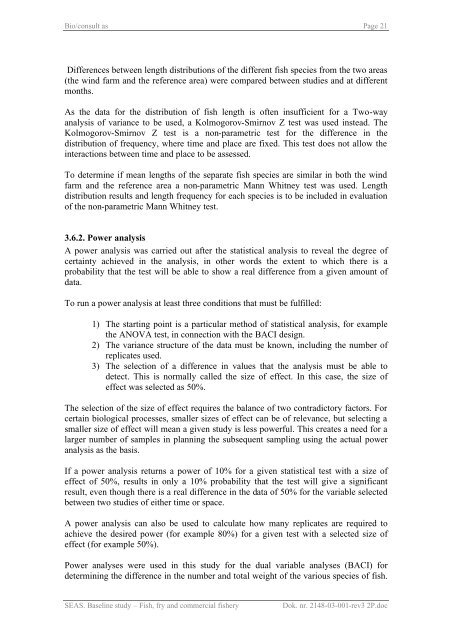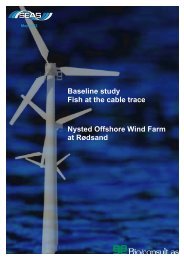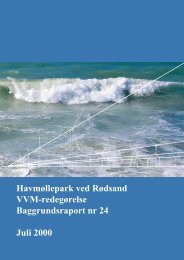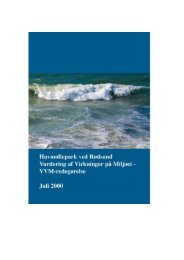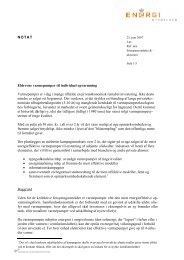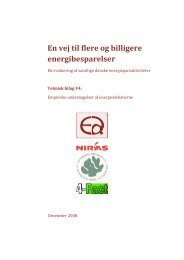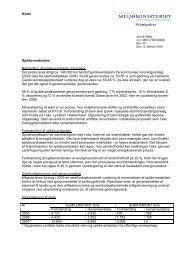Baseline study Fish, fry and commercial fishery Nysted Offshore ...
Baseline study Fish, fry and commercial fishery Nysted Offshore ...
Baseline study Fish, fry and commercial fishery Nysted Offshore ...
Create successful ePaper yourself
Turn your PDF publications into a flip-book with our unique Google optimized e-Paper software.
Bio/consult as Page 21<br />
Differences between length distributions of the different fish species from the two areas<br />
(the wind farm <strong>and</strong> the reference area) were compared between studies <strong>and</strong> at different<br />
months.<br />
As the data for the distribution of fish length is often insufficient for a Two-way<br />
analysis of variance to be used, a Kolmogorov-Smirnov Z test was used instead. The<br />
Kolmogorov-Smirnov Z test is a non-parametric test for the difference in the<br />
distribution of frequency, where time <strong>and</strong> place are fixed. This test does not allow the<br />
interactions between time <strong>and</strong> place to be assessed.<br />
To determine if mean lengths of the separate fish species are similar in both the wind<br />
farm <strong>and</strong> the reference area a non-parametric Mann Whitney test was used. Length<br />
distribution results <strong>and</strong> length frequency for each species is to be included in evaluation<br />
of the non-parametric Mann Whitney test.<br />
3.6.2. Power analysis<br />
A power analysis was carried out after the statistical analysis to reveal the degree of<br />
certainty achieved in the analysis, in other words the extent to which there is a<br />
probability that the test will be able to show a real difference from a given amount of<br />
data.<br />
To run a power analysis at least three conditions that must be fulfilled:<br />
1) The starting point is a particular method of statistical analysis, for example<br />
the ANOVA test, in connection with the BACI design.<br />
2) The variance structure of the data must be known, including the number of<br />
replicates used.<br />
3) The selection of a difference in values that the analysis must be able to<br />
detect. This is normally called the size of effect. In this case, the size of<br />
effect was selected as 50%.<br />
The selection of the size of effect requires the balance of two contradictory factors. For<br />
certain biological processes, smaller sizes of effect can be of relevance, but selecting a<br />
smaller size of effect will mean a given <strong>study</strong> is less powerful. This creates a need for a<br />
larger number of samples in planning the subsequent sampling using the actual power<br />
analysis as the basis.<br />
If a power analysis returns a power of 10% for a given statistical test with a size of<br />
effect of 50%, results in only a 10% probability that the test will give a significant<br />
result, even though there is a real difference in the data of 50% for the variable selected<br />
between two studies of either time or space.<br />
A power analysis can also be used to calculate how many replicates are required to<br />
achieve the desired power (for example 80%) for a given test with a selected size of<br />
effect (for example 50%).<br />
Power analyses were used in this <strong>study</strong> for the dual variable analyses (BACI) for<br />
determining the difference in the number <strong>and</strong> total weight of the various species of fish.<br />
SEAS. <strong>Baseline</strong> <strong>study</strong> – <strong>Fish</strong>, <strong>fry</strong> <strong>and</strong> <strong>commercial</strong> <strong>fishery</strong> Dok. nr. 2148-03-001-rev3 2P.doc


